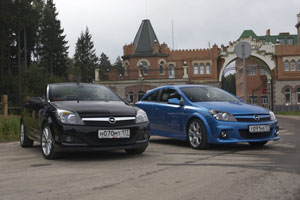Test drive Opel Astra sedan 1998 - 2008 sedan
Opel Astra 1.6
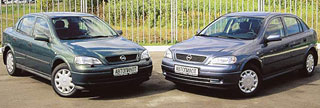 The autopilot evaluates cars according to five main criteria. The amount of advantages is indicated - b, the sum of the deficiencies - Ch. The next subject gained four B and one ch. This is Opel Astra.
The autopilot evaluates cars according to five main criteria. The amount of advantages is indicated - b, the sum of the deficiencies - Ch. The next subject gained four B and one ch. This is Opel Astra. EXTERIOR. In the flowerbed of the German Rüsselheim, Astra blossomed in 1998, and a year ago it was subjected to light facies. Today in the Russian market this model is presented in three types of body: a sedan, a five-door hatchback and a caravans-universal. There is also a compartment, but this is a separate story - it cannot be attributed to the category of budget cars. Astra lines are strict and concise in German, the car looks more solid than many classmates. There is something in it that in Russia they say: okay is cut and firmly sewn.
Bamers and external mirrors in standard configuration are painted in the color of the body, on the thresholds and door handles - plastic overlays. Glass - athermal, with a slight tint. The buyer is offered a rich selection of body colors: four main, nine metallic and one so -called diamond. A thorough anticoros, double door seals (anti -frying package), front shers and mudguards on all wheels, as well as a package for bad roads - all this is included in the basic package. The body is given a factory 12-year guarantee. For external data - 5 B.
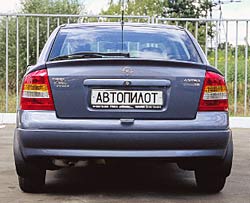
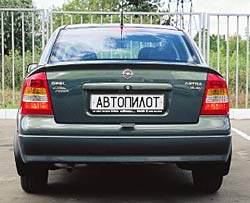
INTERIOR. It is somewhat boring, but in a Germanic monumental, solid and very neatly executed. The soft polyurethane of the torpedo, dense and practical velor of muffled tones on hard seats, from which inserts in the door panels are also made, a practical light -fitting sheathing of racks and ceiling is Astra.
There are two shelves in the voluminous glove compartment, and its lid opens stepped, with an intermediate position, and does not fall to the passenger knees. There are no cup holders, but in the pockets on the sheathing of all doors there are containers for cans or plastic bottles. Astra salon, with small dimensions, is very spacious and equally convenient for both the driver and passengers. The backs of the front seats are equipped with pockets and have a concave shape, so that passengers do not have to rest on the back. Due to the 1/3 of the rear seats folding in the ratio of 1/3 to the ratio of 2/3 and the vertically rising pillow, the useful volume of the luggage compartment can vary from 460 to 1230 liters in the sedan and from 370 to 1180 liters in the hatchback. In the caravan, these figures are even more impressive - from 480 to 1,500 liters. 4 b, 1 h.
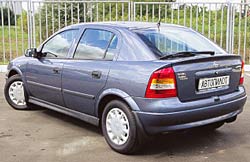
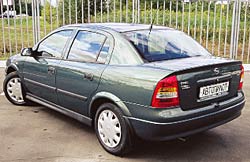
Equipment and ergonomics. The presented cars are two options for the basic configuration. They are both equipped with power hydraulic power steering with varying effort, air conditioning, a driver’s airplane pillow adjustable in height belts with pyrotechnic pretensors and a system of active front head restraints.
The instrument shield contains a traditional set: temperature and fuel indicators, a tachometer and a speedometer with an electronic display of the odometer and a daytime path. In the upper part of the central console there is a large display, where information is displayed about the date, time and air temperature overboard. The steering column, even in the simplest configuration, is adjusted both in the corner of the inclination and by departure. The second basic version is also equipped with an electric side of side mirrors with heated and front windows with a safety module and an automatic mode (in the first version, both mechanical). Also, the driver’s and passenger seat is equipped with heating with multi -stage temperature adjustment. In both versions there is a complete radio training by the principle of simply add the radio. These are pluses. The disadvantages include the absence of lumbar support in the driver's seat, which is why, due to not the best configuration of the back, it causes certain difficulties for a long time at the wheel. We also add the pedal here. Their sites are very small, and the brake pedal is located too low and gets somewhere in the lower part of the foot, closer to the heel. For some reason, light in the cabin can only be turned on from the driver's seat, and when opening the doors, it always ignites, regardless of your desire. To the pluses, you can add the presence of a central lock with remote control and double lock, as well as a full -sized spare wheel. 4 b, 1 h.
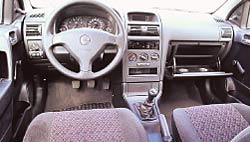
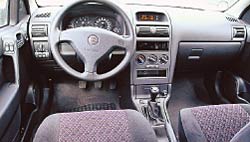
ROAD. Contrary to expectations, the fundamental difference between 8-valve and 16-valve engines could not be found. In terms of dynamics and traction characteristics, they are very close. The difference in power, of course, will affect the full load of the car. And in a situation where one or two people are in the car, the differences are difficult to do. Both engines are well balanced, they are suspended on hydraulic power, vibrations are minimal. That is, they are felt on the steering wheel, but just enough to understand in what mode the engine works. The same applies to sound insulation. The operation of the electro -hydraulic power is a very good impression: the steering wheel is moderately heavy, informative, with a good reactive effect, but in normal modes. If you try to polyghty a little, then at some point, especially with sharp maneuvers, information content is somewhat decreased. However, even at high speed, the car confidently holds the road and is stable in corners. The gear shift is clear and light, the clutch pedal is moderately tough.
But the so -called Russian suspension adaptation is a stick about the two -edges. On the one hand, increased energy intensity and elasticity allow you not to notice small pardon and potholes, and the clearance enlarged by a couple of centimeters allows the heart not to freeze in fear when you pass some sticking lid of the hatch between the wheels. And on the other hand, it inevitably affects controllability, especially in high -speed modes. 4 b, 1 h.
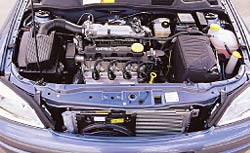
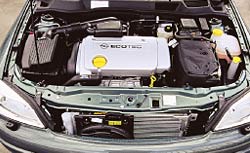
Features of national operation. The factory warranty on Astra in Russia is one year without limiting a run. True, some dealers add another year on their own, but with an indispensable condition for maintenance only at their service center. The price of a norm-watch ranges between $ 25 and $ 30. The duration of the interservice run for these cars is 15 thousand km. The cost of regulatory is the first 15 thousand km will be an average of $ 80 (including the cost of work and materials), in the first 30 thousand km this figure will increase to $ 150. Then, depending on the mileage and the volume of the necessary work, the maximum will be $ 280, and the minimum will remain at the level of the same $ 80.
Both engines normally digest Russian gasoline, although, as usual, before the planned 60 thousandth replacement of the candle rarely live. For a 16-valve engine of the Ecotec series, the failure of the system often threatens to replace the entire cassette of the direct ignition system, which is about $ 300. Salt on the roads often leads to the refusal of the control unit of the engine cooling fan, which is located in a very unsuccessful place - in front under the bumper. The same salt and dirt of Russian roads are very harmful for calipers of rear disc brakes and a manual brake mechanism. A weak place is a pump. 40 thousand km for her this is already a critical age.
The suspension is quite strong, 90--100 thousand km shock absorbers and springs, as a rule, pass. Front brake discs survive normally 60 thousand km. The viability of other expendable elements of the suspension-silent blocks, ball supports and stabilizer racks-is highly dependent on driving and road quality, but on average it is estimated at 30-40 thousand km. But the muffler and resonator with intensive winter operation often do not experience two winter - remaining outwardly intact, they pour out from the inside. 4 b, 1ch.
Our sentence. A solid, budgetary and comfortable purebred German car for a very moderate price, which is quite consistent with its technical and consumer qualities. Without complaints, for daily use, both in the role of family and official city cars. 4 b, 1 h.
Text Andrey Timofeev, photo Alexey Ilyin
Cars are provided by Gema, (095) 442-3224. Technical consultations of the Opel service center MBL Motors, (095) 900-1101. Insurance is carried out by Ingosstrakh, (095) 956-5555.
Model/Modification Opel Astra 1.6 1.6 16V
Hatchback Sedan body
ENGINE
Gasoline type with multi -flowing electronic injection gasoline with multi -point electronic injection
Front location transversely in front transversely
Working volume (cubic cub) 1598 1598
Number/location of cylinders 4/rowing 4/row
Power (L.S. at about. /Min.) 84 at 5400 100 at 6000
Max. torque 138 at 2600 150 at 3600
TRANSMISSION
Front front drive
Gearbox mechanical 5-speed mechanical 5-speed
SUSPENSION
The front independent spring type Mcphereson, with a reptile stability stabilizer, on a subframe
The back of a semi -dependent spring, a beam on longitudinal levers, elastokinematic couplings
The steering gear-rack with an integral-type electro-hydraulic system with an integral-type electro-hydraulic system
Brakes
Front discount ventilated ventilated disk
Rear drum disk
Dimensions/volumes/weight
Length/width/height 4110/1709/1425 4252/1709/1425
Mass, equipped/full 1105/1625 1085/1605
Dynamic characteristics
Maximum speed 180 188
Acceleration to 100 km/h (sec.) 14.5 11.5
Fuel consumption (l per 100 km, city/highway) 9.5/5.5 9.5/5.5
The price in Moscow is $ 13.8 thousand $ 15.7 thousand.
Source: "Autopilot"
Test drive Opel Astra Sedan 1998 - 2008
Crash Test Opel Astra Sedan 1998 - 2008
Krassh Test: Detailed Information25%
Driver and passengers
7%
Pedestrians





